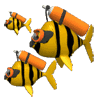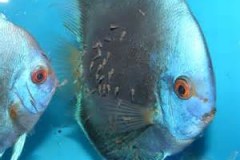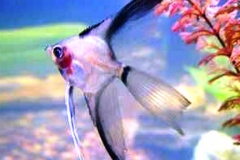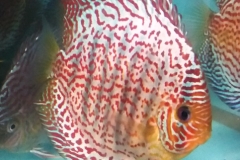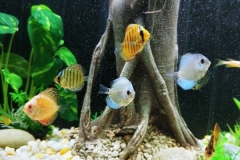The German Blue Ram is a beautiful but sensitive freshwater tropical fish requiring warm water, proper and appropriate diet and peaceful tank mates for best health and longevity. They are great tankmates for Discus Fish and Angelfish. They come from the same rivers in the Amazon Basin as do Discus Fish and Angelfish.
Tank Setup and Water Parameters
- Tank Size: Minimum of 20 gallons for a pair or trio to ensure ample swimming space and reduce territorial stress .
- Temperature: Maintain between 78°F and 86°F (25°C to 29°C). Stable warmth is crucial as sudden drops harm them .
- pH: Ideally 6.0 to 7.5, often slightly acidic (6.0-6.5) mimicking their native slow-moving, tannin-rich South American waters .
- Water Hardness: Soft to moderately hard water, with a TDS under 250.
- Filtration & Flow: Use gentle filtration with slow water flow since they come from calm waters; biological filtration is essential to maintain pristine water quality .
- Substrate: Medium or soft substrate is recommended as they sift the substrate for food . Avoid sharp gravel that can injure them.
- Important: Avoid over-crowding the tank.
Diet and Feeding
- German Blue Rams are omnivores: feed a varied diet including high-quality sinking pellets or flakes designed to provide a variety of animal and plants nutrition.
- Freeze Dried Bloodworms, Tubifex, , Brine Shrimp (live, frozen and freeze dried) and Daphnia.
- Feed 2-3 small meals per day, only as much as they consume in 10 minutes to avoid overfeeding and maintain water quality.
- They can be picky when first introduced, so frozen/live food often encourages feeding.
Behavior and Tank Mates
- German Blue Rams are generally peaceful but can territorial among themselves, especially during breeding.
- They thrive in community tanks with other small, peaceful fish that share similar water requirements, including various tetras (Neon, Cardinal, Rummy-Nose), Corydoras catfish, smaller Gouramis, and Plecos. They also do great with Discus Fish and Angelfish.
- Avoid aggressive or large fish that may bully or prey on them (e.g., Oscars, Jack Dempsey, African Cichlids). An exception would be that they generally do well with Severums and Parrot Fish.
- Provide hiding places and visual barriers to reduce stress and aggression.
- Pairs or small groups are recommended, keeping males separated in larger tanks to reduce conflict. We recommend at least 5.
Breeding German Blue Rams
- Pairs form naturally; breeding in captivity is relatively easy but requires stable, slightly warmer water (82-86°F) and soft, slightly acidic water to stimulate pairing of and spawning.
- Provide flat rocks or broad leaves as spawning sites.
- Eggs hatch in about 48-72 hours; parental care is strong, but early spawns may be eaten.
- Raise fry with fine foods like Infusoria, Microworms, and later baby Brine Shrimp.
- Separate breeding tank (10-20 gallons) with gentle sponge filtration and minimal stress is advised for best success.
